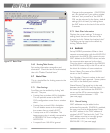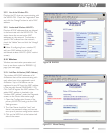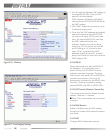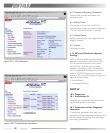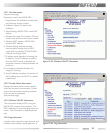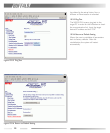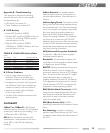
27
of information that is sent in packets across
the Internet or Intranet.
Infrastructure: A wireless network or other
small network in which the wireless network
devices are made a part of the network
through the Access Point.
ISP (Internet Service Provider): A
company that provides access to the Internet
and related services.
IV (Initialization Vector): The header
section of a message packet.
LAN (Local Area Network): A group of
computers and peripheral devices connected
to share resources
LED (Light Emitting Diode): The lights on
a hardware device representing the activity
through the ports.
MAC (Medium Access Control)
Address: The physical address of a network
node.
Mbps (Mega Bits Per Second): A
measurement of millions of bits per second.
MHz (Mega Hertz): A measurement of
millions of cycles per second.
MIB (Management Information Base):
An internal database of commands and data
structures used to define and profile the
capabilities of the device for which it was
written.
MIC (Message Integrity Check): A
method of using a checksum to ensure a data
message is not altered by a third party.
MIPS (Millions of Instructions Per
Second): A measurement of processing
speed.
NAT (Network Address Translation): An
Internet standard that enables a LAN to use
one set of IP addresses for internal traffic and a
second set of addresses for external traffic.
NIC (Network Interface Card): An
expansion board inserted into a computer so
the computer can be connected to a network.
Packet: A block of data that is transferred as a
single unit; also called a frame or a block.
Packet Filtering: Discarding unwanted
network traffic based on its originating address
or its type.
PCI (Peripheral Component Intercon-
nect): A bus that is connected directly with
the CPU.
PCMCIA (Personal Computer Memory
Card International Association) Card: A
PC card suitable for several types of applica-
tions.
Ping (Packet Internet Groper): An
Internet utility used to determine whether a
particular IP address is online.
Plug and Play: Hardware that, once installed
("plugged in"), can immediately be used
("played"), as opposed to hardware that
requires manual configuration.
PoE (Power over Ethernet): A mechanism
to send DC power to a device using a CAT5
Ethernet cable.
PPPoE (Point-to-Point Tunneling
Protocol): A specification for connecting users
on an ethernet line to the internet through a
common broadband medium.
Protocol: A standard way of exchanging
information between computers.
RADIUS (Remote Authentication Dial
In User Service): A server that issues
authentication keys to clients.
RAM (Random Access Memory): Non
permanent memory.
Repeater Hub: A device that collects,
strengthens and transmits information to all
connected devices, allowing the network to be
extended to accommodate additional
workstations.
RC4: The encryption algorithm that is used in
WEP
RJ-45 connector: An 8-pin connector used
for connecting twisted pair cable to a data
transmissions device.



